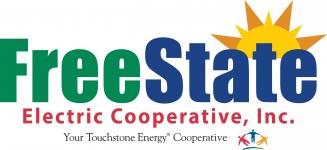 Using the sixth cooperative principle of cooperation among cooperatives, FreeState Electric Cooperative is joining 11 other rural electric cooperatives in Kansas to invest in 20 megawatts (MW) of solar power to be installed across 800 miles of the state, making a small investment for the next 25 years or more in the harvesting of sunshine. Participating electric cooperatives will be able to procure low-up-front cost solar energy to serve their members through the Kansas Cooperative Sun Power Program and reduce their peak demand.
Using the sixth cooperative principle of cooperation among cooperatives, FreeState Electric Cooperative is joining 11 other rural electric cooperatives in Kansas to invest in 20 megawatts (MW) of solar power to be installed across 800 miles of the state, making a small investment for the next 25 years or more in the harvesting of sunshine. Participating electric cooperatives will be able to procure low-up-front cost solar energy to serve their members through the Kansas Cooperative Sun Power Program and reduce their peak demand.
Under their unique cooperative programming, the Kansas Cooperative Sun Power Program is a series of solar farms developed by Today’s Power, Inc. (TPI) to harvest renewable energy in the state for participating electric cooperatives. This 25-year program has attracted the best possible long-term pricing and will result in the construction of more than 20 Megawatts (MW) of solar power spread out across more than 800 miles of the sunflower state.
This opportunity began when the wholesale power contract between all participating cooperatives and their G&T, Kansas Electric Power Cooperatives (KEPCo), was recently modified to provide their member electric cooperatives with the ability to self-procure up to 15% of peak demand, with 5% of that amount specifically earmarked for the addition of solar.
Proving that utility-scale solar provides more cost-effective ways to benefit all consumer-members of the cooperatives, TPI was chosen to be the developer and energy partner for this venture through extensive research undertaken by participating cooperatives and a comprehensive Request For Proposals (RFP) process administered by GDS & Associates.
Owned by Electric Cooperatives, TPI was created to provide solar facilities to Arkansas’ electric cooperatives that could otherwise not utilize federal tax incentives. Fellow cooperatives in neighboring states quickly learned of TPI’s program and wanted a “known business partner” to provide their solar system.
TPI has constructed solar arrays for 15 of the 17 electric cooperatives of Arkansas as well as cooperatives and cooperative organizations in Oklahoma and Tennessee.
All systems under the Kansas program installed will be sized in the 1 MW range. Each system is contracted through a 25-year Power Purchase Agreement with additional 5-year options. Cooperatives will simply be responsible for the purchase of electricity generated from the solar farms and will have low-up front costs associated with the development of renewable solar energy.
This method of generation makes it possible for these cooperatives to increase the production of renewable energy year-round and to reduce peak demand. The reduction of peak demand will enable each cooperative to provide financial stability to its members while also reducing their carbon footprint. This is just another way electric cooperatives in Kansas are helping support local businesses, industries, and individuals with the resources they need to grow as efficient, responsible, and successful contributors to our communities.
FreeState’s portion of the project consists of two 1 MW solar farms. Preliminary work has already begun on the two farms for the project. Construction should be completed by June 2021.
One FreeState 1-MW array, the Oskaloosa Sun Farm, will be located at the substation just south of Oskaloosa on 59 HWY. The second, Stranger Creek Solar Farm, will be located at the Substation Northeast of Tonganoxie near Tonganoxie and Mitchell Roads. Both solar farms will be located in the co-op’s east district due to the power supplier contracts.
Each solar farm will sit on 9 acres and will include approximately 4,000 solar panels. The farm will be customized in the design process to maximize output during the cooperative’s peak demand hours when power is most expensive. These factors will all help FreeState control power costs and keep rates stable for those served at the cooperative’s 20,550 metering points.
“The low-cost investment opportunity we were presented with was huge for FreeState,” said Steve Foss, CEO. “This goes hand in hand with the investment we made in 2018 to install industrial generators at the Lakewood Hills and Oskaloosa substations, bringing our total to four. The purpose of the large investment was to save money through peak demand management. This solar project is a much smaller investment.”
Foss said that the cooperative’s commitment to saving money by managing demand reduces the amount of energy purchased for members, and that means saving money on the wholesale cost of electricity.
“FreeState has clear financial goals, and we look at everything very carefully to determine the feasibility of a project and investment and how it will impact our members in a positive way,” Foss added.
“It’s about financial savings and rate stability, and these solar farms will help us achieve that,” added Foss. “This low-cost investment is a cost-effective way for us to not only save money but help reduce our carbon footprint.”
National data shows that solar power is growing quickly across the country. FreeState currently has more than 1 MW of energy produced by member-owned solar panels. Investing in these two large arrays means that FreeState’s consumer-members will benefit from the clean, affordable power supplied, not just those that put panels on their own homes.
FreeState’s investment in solar is just one more way the cooperative works to lower power use during peak hours and control the cost of power.

